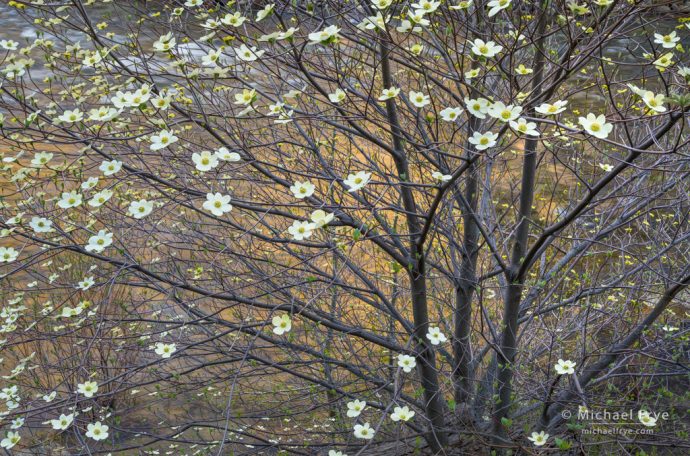
Dogwood above the Merced River, Yosemite. To find this composition I used my iPhone to “sketch” different possibilities. The composition I liked best required holding the phone high over my head, but luckily my tripod went high enough to put my Sony camera up there. 50mm, 1/3 sec. at f/16, ISO 100, focus stacked.
Despite the dry winter – or maybe because of it – it’s been a good year for dogwoods. These things always vary, of course, because that’s the way nature works. The relationships between plants and their environment is incredibly complex. Weather is a big factor, including moisture, temperature, and sunlight. But every plant is affected by soil, by microorganisms in the soil, by animals (especially insects) that want to feed on it, by animals that feed on the animals that want to feed on it, by animals that might pollinate its flowers, and by neighboring plants it competes with, or, sometimes, cooperates with. And the way each plant responds to all those factors is influenced by its own genetics.
Which is to say that not every dogwood lives under the same conditions, and even if they did, they wouldn’t all respond to those conditions in the same way. So when I say that it’s been a good year for dogwoods, it would be more accurate to say that it’s been a good year for many dogwoods, though not all. Some have produced average or below-average blooms. But this year many dogwoods have produced above-average blooms. Some are incredibly full, to the point where it’s hard to imagine where another blossom would fit.
Our Pacific dogwoods bloom for a long time compared to most other wildflowers. An individual annual or perennial flower like a poppy or lupine might bloom for a week or so. But an individual dogwood blossom could last three or four weeks. And the white petals (actually bracts) grow larger over that time. Having said that, by the end of the second week or so those large, white, showy bracts usually start to look a bit ragged and worse for wear as they’re shredded by insects and the wind. So most of the dogwoods in Yosemite Valley are past their prime photographically, but their higher-elevation cousins are just getting started.
When a special event occurs in Yosemite, Claudia and I always try to enjoy it. This profuse dogwood bloom definitely qualifies as that kind of special event to us, so we’ve made several trips to Yosemite Valley to see and photograph the dogwoods this spring.
Some of my favorite locations for photographing dogwoods have been closed off due to construction, but that forced us to look elsewhere, and led us to some beautiful spots (at least they were beautiful this year) that we hadn’t explored in depth before. After photographing Yosemite Valley for 35 years, it’s always fun to discover some new little nooks and crannies.
Of course I’ve photographed dogwoods many times in previous years as well, and it’s a challenge to find new ways of portraying a familiar subject, no matter how beautiful that subject is.
One thing I did was concentrate on what was unique and different this year, which to me meant trying to show the sheer abundance of flowers on some of the trees. I also did some slight variations on the familiar theme of dogwoods-and-gold-reflections by showing somewhat wider views, while still trying to keep the compositions clean and simple. I also found a composition that juxtaposed dogwood blossoms with a waterfall. And while I usually prefer to photograph intimate scenes like these in soft light, I sometimes pushed myself to use sunlight, especially backlight, to give some of the images a bright, sunny, springtime feeling.
Nature continually surprises me. Most of California’s wildflowers responded to our dry winter as you’d expect – by blooming sparsely, or not at all. But the dogwoods in Yosemite decided that conditions were perfect for them, and put on a beautiful show. I can’t wait for the next surprise.
— Michael Frye
P.S. To all you moms out there, Happy Mother’s Day! My mom loved dogwoods, and in Yosemite they typically bloom around Mother’s Day, so they always make me think of her.
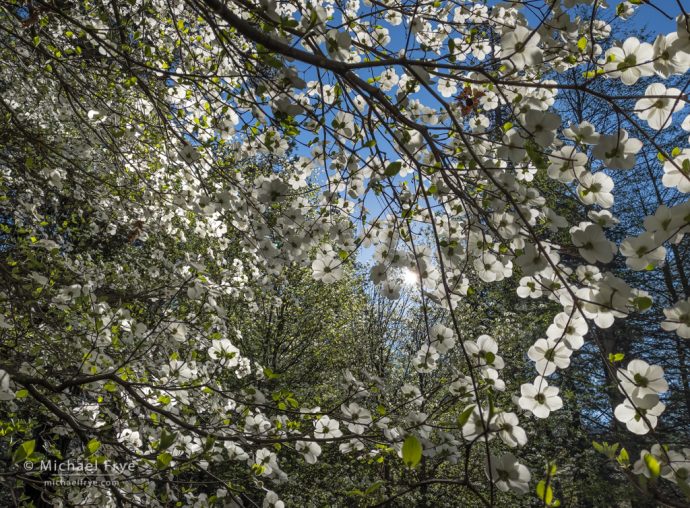
Sunlit dogwoods, Yosemite. This composition required holding the camera up over my head among the branches of the tree. It would have been impossible to get my big camera into that position on a tripod, and then focus-stack to get everything in focus with the branches moving in the breeze, so I used my iPhone and the ProRAW format to capture this image.
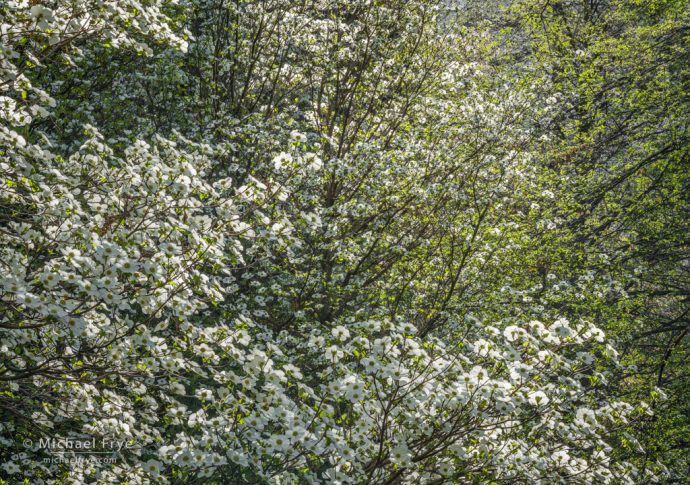
Spring dogwoods, Yosemite. I liked the layers and sheer abundance of blossoms in this scene. 104mm, 1/90 sec. at f/16, ISO 100, focus-stacked.
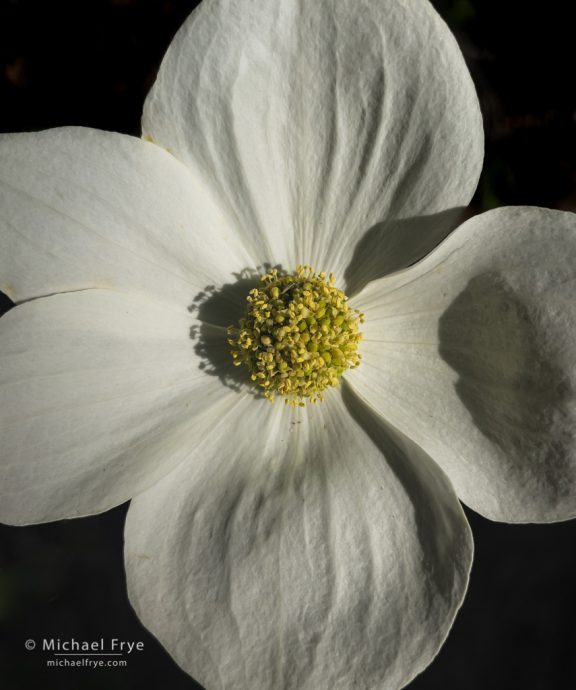
Dogwood blossom, Yosemite. Another iPhone image in ProRAW format. This was easy to capture with my phone, but would have been challenging to photograph with my big camera since the blossom was waving in the breeze.
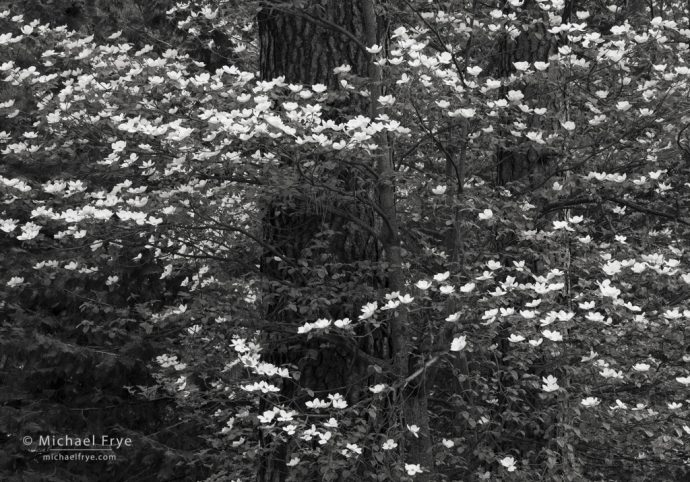
Dogwoods and pines, Yosemite. I like how the black-and-white rendering emphasizes the patterns of the blossoms. 145mm, 1/4 sec. at f/16, ISO 100.
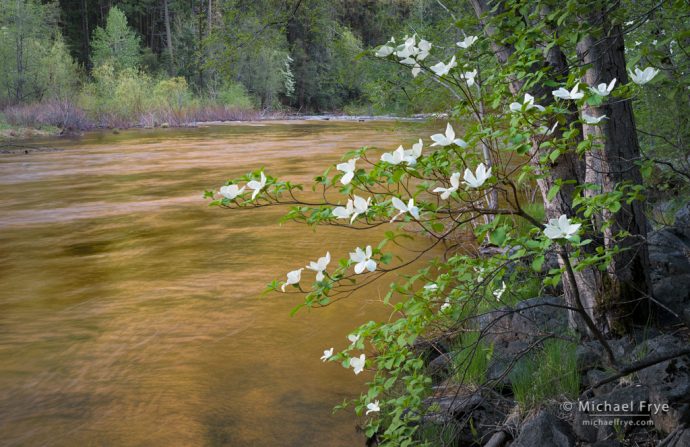
Dogwood along the Merced River, Yosemite. This composition required perching the tripod atop a log to get it as high as possible, and a lot of patience to wait for the branches to be still long enough to capture a focus-stacking sequence. 50mm, 1.5 seconds at f/16, ISO 100, focus-stacked.
Related Posts: A Good Year for Dogwoods; Dogwood Composition
Michael Frye is a professional photographer specializing in landscapes and nature. He is the author or principal photographer of The Photographer’s Guide to Yosemite, Yosemite Meditations, Yosemite Meditations for Women, Yosemite Meditations for Adventurers, and Digital Landscape Photography: In the Footsteps of Ansel Adams and the Great Masters. He has also written three eBooks: Light & Land: Landscapes in the Digital Darkroom, Exposure for Outdoor Photography, and Landscapes in Lightroom: The Essential Step-by-Step Guide. Michael has written numerous magazine articles on the art and technique of photography, and his images have been published in over thirty countries around the world. Michael has lived either in or near Yosemite National Park since 1983, currently residing just outside the park in Mariposa, California.

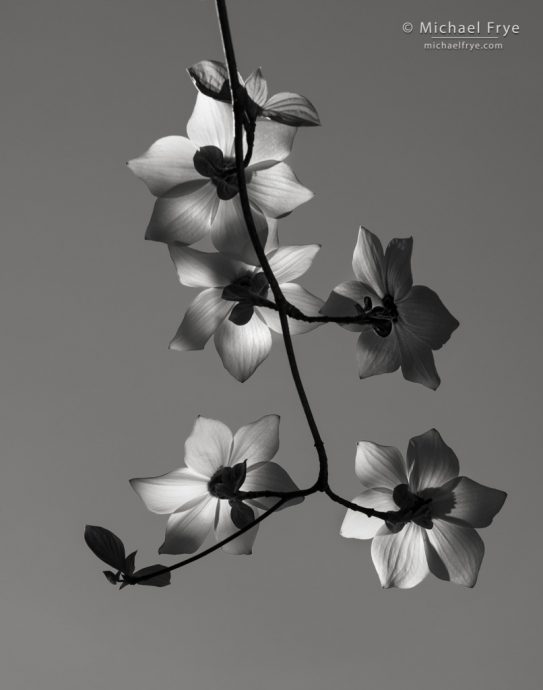
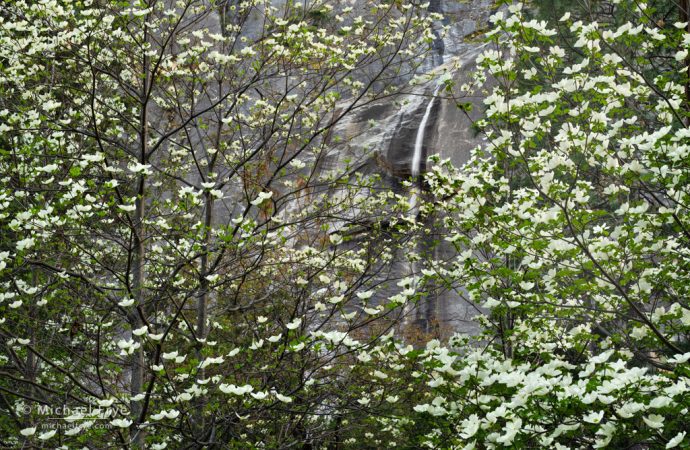
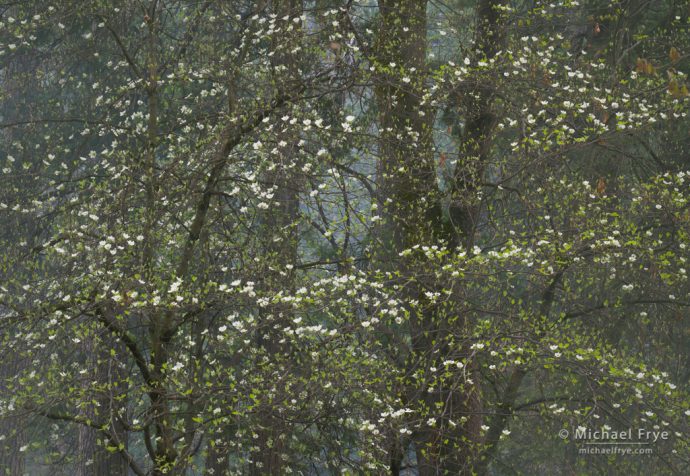








Hi Michael, I love the backlit dogwood blossoms in black and white. I am sure it was lovely to be out and about!
Thanks very much Vivienne!
I second that opinion on the backlit b & w. Stunning.
I appreciate that Michael – thanks!
Thank you for the report and wonderful photos as always.
Do you think they are still good this weekend (5/15~5/16)?
Thanks Moon. As I wrote, they’re past their prime in Yosemite Valley, though just getting started at higher elevations. I think it’s still possible to make good dogwood photos in the valley, but with every day that passes the opportunities diminish.
A great collection of dogwoods. I really like the “Light and Shadow on Dogwoods” or should I say I like it a little more than the others. Spring is such a beautiful time for photography. Nice job.
Thanks very much Randy!
Well done yet again, Michael! It is always fun to discover new subjects after all of these years.
Indeed it is! Thanks Bill!
Love taking photos of Dogwood blossoms and Redbuds combine! Just so lovely Michael.
Thanks very much Randy!
Michael, Magnificent captures…
Thank you Tom!
Michael,
Thanks for the update and stunning images. That image of the blossoms in black and white is breathtaking! Makes me yearn for the days of Pan-X.
Rudy
Thank you Rudy! Black-and-white is great – though I like the control that digital capture gives me compared to film.